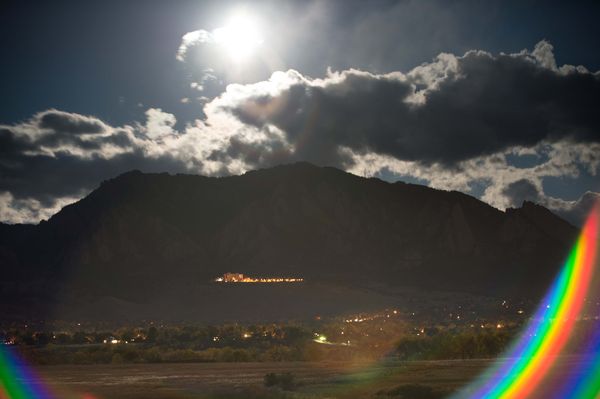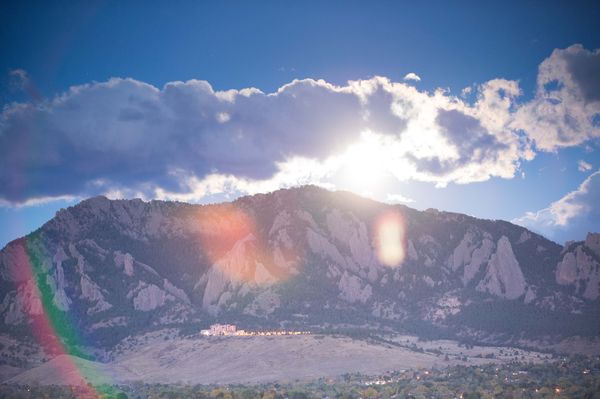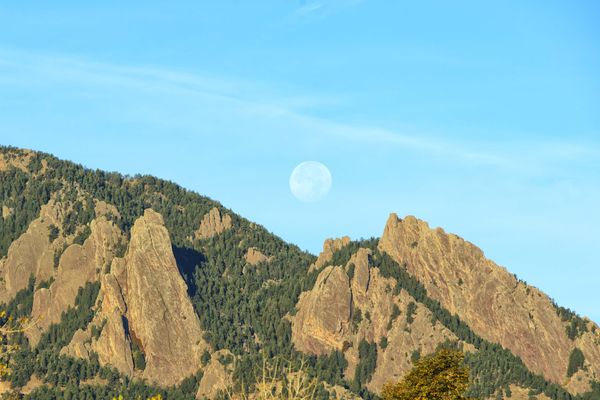Check out People Photography section of our forum.
Really bad lens flare
Oct 30, 2015 13:09:25 #
I was out Tuesday morning, Oct 27, trying to catch the full moon setting over the Flatirons.
There was only one minute of overlap between sunrise (7:25 a.m.) and moonset (7:26 a.m.). In addition, the moon would vanish behind the Flatirons well before sunrise because of the elevation of the Flatirons relative to my site.
So I knew I would be shooting a very high contrast (high dynamic range).
I thought I would try using a GND to reduce some of the brightness of the full moon, and chose a 3-stop hard-edge Lee filter.
Lens was "The Beast", Nikon 80-200mm f/2.8 AF-S. Camera was Nikon D4.
With the Lee filter holder, of course, it was impossible to also have the lens hood in place. I did remove the Nikon NC filter I usually use to protect the front surface of the lens.
Talk about a learning experience! Although I am not certain what I learned, other than it would take at least a 10-stop GND to tame to brightness of a full moon. And I'm not sure about that.
I shot a 5-bracket set for every shot, with 2.0EV steps.
Anyway, my question has to do with lens flare.
The first photo was shot at 6:22 a.m., an hour before sunrise, with the GND filter in place. Settings were 100mm, f/2.8, ISO 1000 and +4.0EV, aperture preferred. The camera chose 8 sec for the shutter speed, and you can clearly see motion blur in the clouds.
But where did the lens flare come from? In addition to the rainbows, there is a light patch lower center. I was completely unprepared for the flare, and still do not know where it came from.
The second photo was shot at 6:45 a.m., still 45 minutes before sunrise. The GND was still in place. Settings on tis one were 130mm, f/2.8, ISO 3200, and +2.0EV, aperture preferred. Shutter speed was 2 sec (much less motion blur in the cloud).
There is still a faint rainbow in the lower left corner, and two prominent bright spots near the center of the image.
I'm interested in any and all explanations, and, of course, in avoiding this in the future. I did learn that the dynamic range is extremely high (too high for my limited skills right now), and went out the next morning (Wednesday, Oct. 28), when the moon did not set until over an hour after sunrise, thereby greatly reducing the contrast, and got a very good photo (no GND filter, lens hood in place). Photo #3 is a 5-shot bracketed set combined in Photomatix Pro 5.
There was only one minute of overlap between sunrise (7:25 a.m.) and moonset (7:26 a.m.). In addition, the moon would vanish behind the Flatirons well before sunrise because of the elevation of the Flatirons relative to my site.
So I knew I would be shooting a very high contrast (high dynamic range).
I thought I would try using a GND to reduce some of the brightness of the full moon, and chose a 3-stop hard-edge Lee filter.
Lens was "The Beast", Nikon 80-200mm f/2.8 AF-S. Camera was Nikon D4.
With the Lee filter holder, of course, it was impossible to also have the lens hood in place. I did remove the Nikon NC filter I usually use to protect the front surface of the lens.
Talk about a learning experience! Although I am not certain what I learned, other than it would take at least a 10-stop GND to tame to brightness of a full moon. And I'm not sure about that.
I shot a 5-bracket set for every shot, with 2.0EV steps.
Anyway, my question has to do with lens flare.
The first photo was shot at 6:22 a.m., an hour before sunrise, with the GND filter in place. Settings were 100mm, f/2.8, ISO 1000 and +4.0EV, aperture preferred. The camera chose 8 sec for the shutter speed, and you can clearly see motion blur in the clouds.
But where did the lens flare come from? In addition to the rainbows, there is a light patch lower center. I was completely unprepared for the flare, and still do not know where it came from.
The second photo was shot at 6:45 a.m., still 45 minutes before sunrise. The GND was still in place. Settings on tis one were 130mm, f/2.8, ISO 3200, and +2.0EV, aperture preferred. Shutter speed was 2 sec (much less motion blur in the cloud).
There is still a faint rainbow in the lower left corner, and two prominent bright spots near the center of the image.
I'm interested in any and all explanations, and, of course, in avoiding this in the future. I did learn that the dynamic range is extremely high (too high for my limited skills right now), and went out the next morning (Wednesday, Oct. 28), when the moon did not set until over an hour after sunrise, thereby greatly reducing the contrast, and got a very good photo (no GND filter, lens hood in place). Photo #3 is a 5-shot bracketed set combined in Photomatix Pro 5.
#1 6:22 a.m., October 27

(Download)
#2 6:45 a.m., October 27

(Download)
#3 7:56 a.m., October 28

(Download)
Oct 30, 2015 13:47:06 #
I admire your dedication to the art and the learning. :thumbup:
Oct 30, 2015 13:49:55 #
big-guy wrote:
I admire your dedication to the art and the learning. :thumbup:
Thank you. Just when I think I have things figured out, something like this comes along.
Check out Close Up Photography section of our forum.
Oct 30, 2015 14:54:43 #
Because you tried to expose for the landscape, not the brightness of the moon, the light and lens flare appear to be similar to what you'd find when shooting towards the sun. Just way too bright. I wonder if the filter made the flare worse?
If you had exposed for moon details, you'd have no detail in the rest of the image, just black.
As you discovered, there are usually a couple of days near the time of full moon when either moonrise/sunset or moonset/sunrise synch up to provide ideal exposure for both.
#1 is my moonset last month, on Sept 28, with no bracketing or ND filter:
http://www.uglyhedgehog.com/t-340986-1.html
If you had exposed for moon details, you'd have no detail in the rest of the image, just black.
As you discovered, there are usually a couple of days near the time of full moon when either moonrise/sunset or moonset/sunrise synch up to provide ideal exposure for both.
#1 is my moonset last month, on Sept 28, with no bracketing or ND filter:
http://www.uglyhedgehog.com/t-340986-1.html
Oct 30, 2015 16:19:36 #
Years ago, I purchased a FlareBuster. You might check to learn
if that company still exists.
if that company still exists.
Oct 30, 2015 17:59:14 #
Linda From Maine wrote:
Because you tried to expose for the landscape, not... (show quote)
What time was sunrise in your area on Sept. 28?
Thanks.
Oct 30, 2015 17:59:40 #
nosretep wrote:
Years ago, I purchased a FlareBuster. You might check to learn
if that company still exists.
if that company still exists.
Thanks. I'll check it out.
Check out Astronomical Photography Forum section of our forum.
Oct 30, 2015 22:32:22 #
bdo wrote:
What time was sunrise in your area on Sept. 28?
Thanks.
Thanks.
Official sunrise was 6:57 a.m. I took the shot about 7:12 a.m. Official moonset said 7:35 but I know from previous shooting, that we lose it quicker than that due to the Cascade Mountain foothills to the west.
Here is the site I use for the times:
http://aa.usno.navy.mil/data/docs/RS_OneDay.php
Oct 30, 2015 22:49:01 #
Linda From Maine wrote:
Official sunrise was 6:57 a.m. I took the shot about 7:12 a.m. Official moonset said 7:35 but I know from previous shooting, that we lose it quicker than that due to the Cascade Mountain foothills to the west.
Here is the site I use for the times:
http://aa.usno.navy.mil/data/docs/RS_OneDay.php
Here is the site I use for the times:
http://aa.usno.navy.mil/data/docs/RS_OneDay.php
Thanks.
So you shot about 15 minutes after sunrise. It's pretty clear to me now that an overlap of half an hour to an hour and a half (sunrise before moonset) is about optimal for these shots.
I've used that site, as well, but I'm more inclined to use the Photographer's Ephemeris now, because I can figure out where I need to stand to have the moon in the right position relative to the Flatirons.
Thanks for your help.
Oct 31, 2015 08:26:31 #
You're very welcome. I tried one of the "position" websites for last moonrise. Doesn't help me much when I have no GPS or smartphone :)
I've also successfully taken landscape photos at moonrise when sunset was no more than a few minutes after. I love seeing the huge orange orb just as it comes into view above the horizon!
I've also successfully taken landscape photos at moonrise when sunset was no more than a few minutes after. I love seeing the huge orange orb just as it comes into view above the horizon!
bdo wrote:
Thanks.
So you shot about 15 minutes after sunrise. It's pretty clear to me now that an overlap of half an hour to an hour and a half (sunrise before moonset) is about optimal for these shots.
I've used that site, as well, but I'm more inclined to use the Photographer's Ephemeris now, because I can figure out where I need to stand to have the moon in the right position relative to the Flatirons.
Thanks for your help.
So you shot about 15 minutes after sunrise. It's pretty clear to me now that an overlap of half an hour to an hour and a half (sunrise before moonset) is about optimal for these shots.
I've used that site, as well, but I'm more inclined to use the Photographer's Ephemeris now, because I can figure out where I need to stand to have the moon in the right position relative to the Flatirons.
Thanks for your help.
If you want to reply, then register here. Registration is free and your account is created instantly, so you can post right away.
Check out The Dynamics of Photographic Lighting section of our forum.



